#Visiting York Minster
Explore tagged Tumblr posts
Text


York, England.
#york#yorkshire#england#art gallery#history#city#cathedral#york minster#architecture#statue#summer#britain#uk#united kingdom#visit
0 notes
Text
Yorkshire Gold
It’s time for a British Summer Tour 2024. Why go travelling the world in search of summer sunshine and exotic experiences? Yes, I know, that question has probably already answered itself. In times of undoubted climate change, we can thank the mindless emitters and evidence deniers for the cooler and even wetter British June & July of 2024. Ducks need not engage with this previous…

View On WordPress
#Betty&039;s Tea Rooms#cats#cats humour#food photography#historic cities#historic photography#Italian cuisine#Italian restaurants#photography#summer visits#The Shambles#UK tourism#York#York Minster#Yorkshire
0 notes
Text
What if the houses in tlt were actually British counties (or where I think the characters in gideon the ninth would live if they were British)
9th house (gideon and harrow)- Cumbria, tucked away at the top of the country, pretty much forgotten by most other counties. Stuck back in time (full of traditionalists and racists), cold dark and depressing (more so than the rest of England. There is no way gideon is a southerner
8th house (colum and that prick)- Oxfordshire, enough said, hate those pretentious pricks
7th house ( dulcinea and pro)- Nottinghamshire, green, pretty close to yorkshire *wink wink*
6th house (pal and camilla)- Yorkshire, no I'm not splitting it into the like five different counties. However palamedes is definitely from York itself just due to the aesthetic, I can see that man walking around the minster. York is full of history/old buildings. Camilla is probably from a more rural area where she cam like bench sheep
5th house (abigail and magnus)- Kent maybe? somerset???their vibes or like wholesome family make me think of a decently well off middle class family who like to go visit the park or a wine tasting
4th house (Jeannemary and issac)- Tyne and wear, specifically because i just want them to have geordie accents
3rd house (the twins and babs)- Essex, i feel like this is so obvious, the gossip, the ridiculous outfits, hair curlers
2nd house (Judith and marta)- Northumberland, for the i was born in blyth but made in the royal navy advert (it wouldve been cumbria cause i feel like that ones more well known), due to the fact their in the cohort
1st house (???)- i have only read gideon the ninth so idk much about the first house but they are london cause yk its london
#slowly extending my hand to the three other british locked tomb enjoyers#do you see the vision?#tlt#the locked tomb#gideon the ninth#harrow the ninth
20 notes
·
View notes
Text
York
20th July 2023 - 24th July 2023
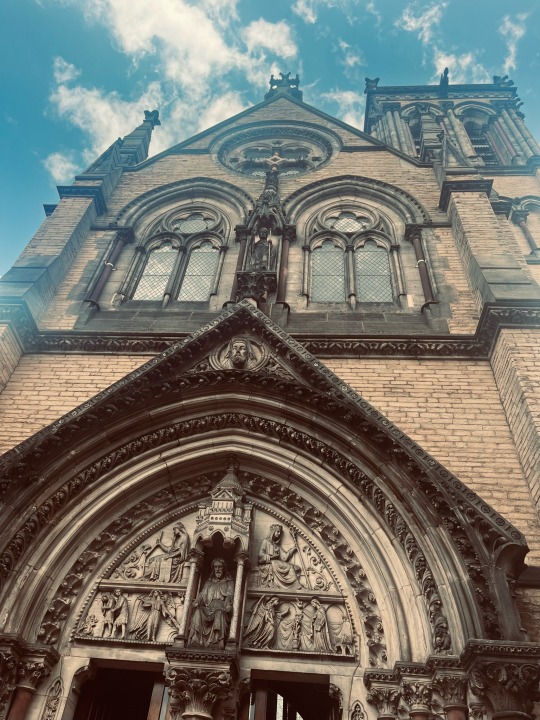
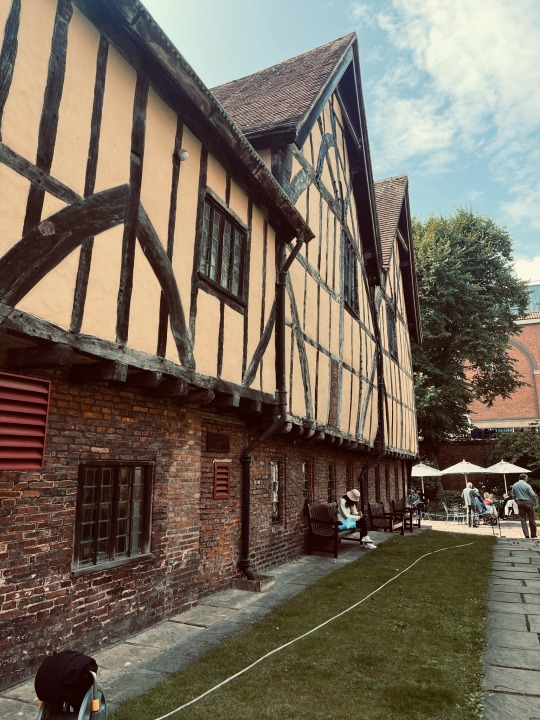
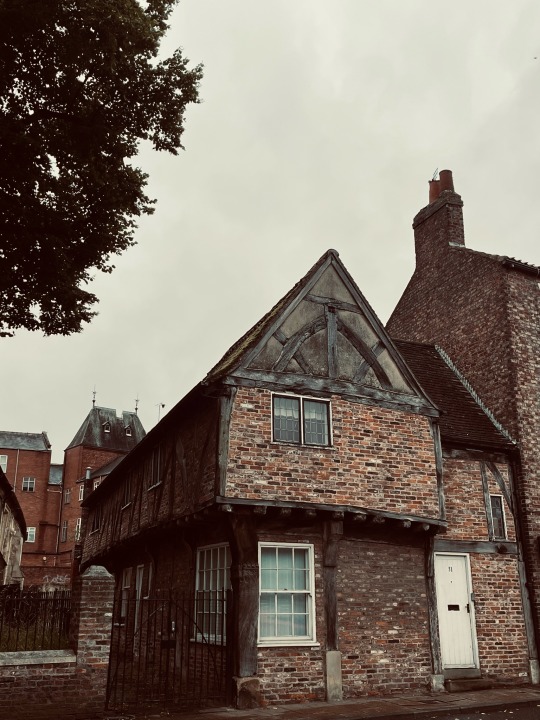



The buildings in York were nothing short of beautiful.
We stayed in an Airbnb down Lady Picketts Yard and I cannot recommend it enough!
My favourite places we visited were:
- Merchants adventurers Hall
- York Muesum and Gardens
- York Minster
Lastly a little clip of the museum gardens!
~images taken by me ~
#yorkshire#York#cottagecore#architecture#beautiful buildings#naturecore#Yorkshire dales#cozy aesthetic#dark acadamia aesthetic#dark aesthetic
30 notes
·
View notes
Text

Royal Visit to York for the wedding of HRH Edward Duke of Kent to Miss Catharine Worsley at York Minster
19 notes
·
View notes
Text
"The memory of [Emma of Normandy] was of a generous patron. At Ely an inventory made in 1134 listed her gifts of precious textiles to the church. They included an altar frontal worked in gold and silver with an image of Christ in majesty, seven cloths with gold worked fringes (orfrey) and one of rich purple fabric, perhaps shot silk taffeta (purpura), adorned all round with orfrey work and precious stones, a purpura pall for each saint and each altar, and four woollen dorsals. The twelfth-century Ely monks also recalled a blood red altar cloth with a gold border a foot wide, and the magnificent purpura one worked with orfrey and adorned in a chequer pattern with gold and gems which she made for them, as well as the gold and gem-worked silk cloths for each saint,’ and, richest of all, the cloth she gave to cover the tomb of St Æthelthryth. The twelfth-century Abingdon Chronicler told of the gold and silver shrine she and Cnut had given to the church. It bore an inscription recording the two hundred and ten mancuses of gold and twenty-two pounds of silver which had gone into its construction. At Winchester they remembered her striving with Bishop Ælfwine to adorn the church of St Swithun, a contest which she won.” Canterbury tradition recorded the cup of gold worth 13 marks, two altar cloths, two copes with gold tassels, and a golden ornamented text which Emma had given.
Canterbury was not the only church to which Emma gave books. She sent an English psalter to her brother Robert, Archbishop of Rouen. She and Cnut have been associated with a lively production of de luxe manuscripts in the third decade of the eleventh century, most of which were intended as gifts for English and foreign churches or individuals. Gifts of manuscripts linked Emma and Cnut with such English churches as York, Canterbury, London, New Minster and Bury, and with cross- Channel recipients in Germany, Scandinavia and France. Peterborough, with its strong ties to queens in general and Emma in particular, was a major centre of this production. Wulfstan of Worcester remembered how a skilled scribe and painter of manuscripts who had taught him there as a boy gave Emma and Cnut a psalter, which eventually ended up in Germany. Ervenius was the scribe who taught Wulfstan. He is the same Earnwig who followed Emma’s close associate Ælfsige as abbot of Peterborough.
Emma was an acquirer of relics, and her acquisitions were almost invariably followed by their distribution. When the bishop of Benevento visited England in Cnut’s reign, Emma bought from him the body of St Bartholomew, which he happened to have with him; she gave most of it to Christ Church Canterbury, though retaining the arm for herself. Whilst staying in Rouen after the death of Æthelred she bought the body of St Ouen, which she again split on her return to England, this time keeping the head for herself and giving the body to Canterbury. New Minster was thus particularly favoured by her gift of the head of St Valentinus. A queen’s gifts were much sought after, and sometimes the process of giving was shortcircuited. Emma kept the head of St Ouen; after her disgrace, her goldsmith purloined it from her reliquary and gave it to Malmesbury where his brother was a monk.
Sherborne attracted her largesse in a more standard way. According to Goscelin writing c. 1100, she and Cnut came to visit St Wulfsige’s shrine at Sherborne. There the king pointed out to her the poor state of the church; the poverty of the angelic citizen Wulfsige was an accusation of them, weighed down as they were by gold and jewelled ornament.” It was up to her to repair it. She gave twenty pounds’ worth of silver for the repair of the roof. Sherborne is a rare instance of Emma as a patron of buildings. She may have contributed more than general support and intercession to the development of Bury and St Benet Holme.’ But according to the surviving sources her most generous building patronage was far away in western France where the rebuilding of St Hilaire at Poitiers was in ‘large part paid for by the queen of the English'.
The patronage of both Emma and [her daughter-in-law Edith also included] land. Emma gave Newington to Christ Church, acquiring it from Cnut after Ælfric forfeited it; she bequeathed land at Kirby to Bury, and together with Harthacnut gave land to Ramsey for the soul of Cnut. Edith was remembered as a benefactor of Wells, granting Milverton and Mark to bishop Giso. Emma almost certainly made gifts of land to the Old Minster, Winchester, where she and Cnut were buried: her son Edward confirmed her grant of the urban property of Godebegot in Winchester to the Old Minster, and after 1066 the Old Minster claimed that she had left them land at Hayling Island in reversion, after the death of her servant Wulfweard the White."
-Pauline Stafford, Queen Emma and Queen Edith: Queenship and Women's Power in Eleventh-Century England
#Emma of Normandy#11th century#anglo-saxons#historicwomendaily#my post#cnut the great#I *love* Emma of Normandy I can't believe I forgot about all these posts about her in my drafts 🤡#women in history
15 notes
·
View notes
Text
"Queen Elizabeth II and Princess Beatrice (R) are greeted by Janet Barnes, CEO of York Museums Trust (L), as they visit the Yorkshire Museum after the Royal Maundy Service held in York Minster on April 5, 2012 in York, England. (Anna Gowthorpe-WPA Pool)


#Outing with granny#Queen Elizabeth II and Princess Beatrice#How beautiful#Granddaughter of Queen Elizabeth II and Prince Phillip#Queen Elizabeth II#Princess Beatrice#Royal flashback#British Royal family
23 notes
·
View notes
Text
Day 2 of our York adventure - we're heading out to find Dick Turpin's grave, just around the corner from the hotel, and then we're paying a visit to the Minster to light a candle for my dad and then hopefully, a boat trip this afternoon if the weather is dry. It's been really good being away from home for something other than a funeral and spending some quality time with my mama ♥️
7 notes
·
View notes
Text


On September 29th 1240 Margaret of England, daughter of Henry III of England and Eleanor of Provence, was born at Windsor Castle to King Henry III of England and his wife, Eleanore of Provence.
The second of five children, the first few years of Margaret’s life were spent quietly in the care of what has been described as an affectionate and close family. Her first appearance in historical record came when she was three years old and she took part in a royal event in London with her brother, the future Edward I, aye him of Longshanks infamy.
Margaret’s paternal aunt, Joan, had been married to King Alexander II of Scotland before she died in 1238 and so, as former brothers-in-law, Henry III and Alexander II had a good relationship and were quite fond of one another. When Alexander II welcomed the birth of a son with his second wife, Marie of Coucy, in September 1241 it was only natural that the possibility of a marriage between the young heir to the Scottish throne and Henry III’s eldest daughter be discussed. Margaret and Alexander III were betrothed when she was just four years old.
Alexander became King of Scotland at the age of seven when his father died in 1249 and Margaret became Queen of Scots at the age of eleven on 26 December 1251 when she was officially married Alexander II at York Minster. The marriage was the third youngest of monarchs in British history.
Removed to the harsh climate of Edinburgh and kept quite separate from her husband Margaret became lonely and homesick, she wrote often to her parents and mentioned she was being treated poorly. This created tension between England and Scotland and it was not until 1255 that this was eventually settled and the young Queen was given an opportunity to reunite with her parents at Wark. The visit vastly improved Margaret’s spirits and she returned to Edinburgh feeling much revived.
In 1257 Margaret and Alexander III were held captive by the powerful Comyn family, who demanded the expulsion of all foreigners from Scotland it was only through the intervention of Margaret’s father and the regency council that they were freed. They went on to have three children: Margaret, Alexander and David. Margaret was the only one to live a full life, the boys died aged 20 and 19 respectively. She gave birth to The Maid of Norway, from a previous post this week.
Though her life was quiet there is some scandal which remains unresolved to this day. Margaret had in her employ a young courtier – given to her by her brother – who claimed to have killed her uncle, Simon de Montfort, 6th Earl of Leicester. One day, while walking with a group of ladies and courtiers along the River Tay Margaret is said to have become annoyed with the courtier and either pushed, or had him pushed, into the river. Playful laughter quickly turned to shock, however, when the man was swept to his death by the powerful current. Margaret was said to have been saddened by the event but we will never know exactly what part she played and how she truly felt.
Margaret died at the age of thirty-four on 26 February 1275 at Cupar Castle after falling ill while visiting Fife. She is buried at Dunfermline Abbey in Fife.
9 notes
·
View notes
Text
1974.
Morse is interviewing witnesses to a murder at one of the colleges, and one of them is strikingly familiar. He's a man in his early twenties, a recent medical graduate back visiting friends before heading off to move into a totally different career. He has a posh accent, a friendly smile, warm brown eyes.
Oh he's truly, desperately familiar, and Morse isn't looking too hard into his own motives when he lets the younger man talk him into a drink out, and then a one-night stand, and then something rather more like a friendship played out over Scotch and crosswords and literary quotations.
[More behind the cut....]
He does mention, briefly, that his new friend reminded him of someone else on first meeting. And somehow that turns into a discussion of ancestry, and the young man discusses with some glee the skeleton in his family cupboard: the fact that his paternal grandmother when barely eighteen had a dalliance with a working-class ruffian of the same age from Mile End, of all places. That she'd got pregnant, but her parents wouldn't let her tell the lad, but instead got her engaged to a somewhat stuffy friend of theirs called Richardson.
"Dad hates to talk about it," says Morse's friend, "he's rather a stuffed shirt, especially for a surgeon. But Granny used to love telling me stories. She did come to love my Granddad, I think, but she missed that boy from Mile End all her life." He chuckles, but a little shakily, because he has yet to learn the effortless-seeming confidence he'll spread before him one day. "I'd give anything to meet him."
Morse swallows, heart suddenly in his mouth. And something in his face makes the young man carry on, more intensely.
"Granny told me that she named Dad after him, though he doesn't know. So that's what I have: Frederick, from Mile End. Fathered a child around 1930 when he was just a lad and doesn't even know he did." He laughs, wryly. "Not much to go on, is it."
"Douglas," says Morse, and his voice is shaking but there's a smile in his eyes. "I... I'll need to look into this, but I think. I mean. I think I can help."
The postcard is of York Minster, which is only a half hour drive from where three exiles from Oxford have settled. On the back it reads just:
"Sir,
Un bel di, please could we talk? There's someone I think you should meet. Bring 2 rounds ham and tomato sandwiches. --"
At the day and time thus ordered, Fred Thursday finds Morse standing admiring the rose window, and follows him out to a bench in the Minster gardens. He's torn between confusion and shame, though above all trying to hide how overjoyed he is to see the rusty curls and those haughty, sea-green eyes again. When Morse explains, and introduces the young trainee pilot with a face Fred remembers from his mirror as a long-lost grandson... well, it's good he's already sitting down, is all.
The years past, and they are gentler than they might have been.
Fred lives to see his grandson a captain, to meet his great-granddaughter. To introduce his grandson to his uncle and step-grandmother and eventually even his aunt. To become friends with Morse again, even if quietly, and for the most part only by letter. To relish that Douglas and Morse, despite occasionally enraging each other beyond reason, seem to be friends for life. (He suspects that they might once have been more than that; if they aren't going to tell him though, he's not going to point it out.) Something healed in him that day in York, and it never breaks again.
When Captain Douglas Richardson puts down the bottle, in an attempt to salvage something of his career and his relationship with his daughter, perhaps it's partly because he's still grieving for his grandfather, dead some ten years now, but most of all because he's still grieving for his friend and one-time lover, and doesn't want to die so young himself.
When First Officer Douglas Richardson meets his new captain at MJN's portacabin in Fitton, he's a little strikingly familiar too. He's shorter, and more pompous, and vastly less good at word games, but there are rusty curls and haughty sea-green eyes.
He's no relation of Morse's at all though, it turns out. This is, eventually, rather a relief.
#ficlet#itv endeavour#e morse#endeavour morse#cabin pressure#douglas richardson#fred thursday#martin crieff#well this rather ran away from me but hopefully someone else will have fun with it too ;-)#ridiculous crossover time#endeavour#roger allam#long post#tw alcoholism mention#tw canonical character deaths#tw complicated family history mention
45 notes
·
View notes
Text
highlights since moving here:
maltesers (sorry)
found lactose free cheddar cheese which was nice
the bus is only $1.31
visited york minster and saw very beautiful stained glass
saw two foxes already :)
cons since moving here:
tried looking for salsa. found "medium salsa", bought it, tried it, and it was milder than mild
i swear to god my city changes its layout at night because my friend and i can navigate perfectly well during the day using little to no maps but at night it's entirely different and we keep getting lost
i don't have any moisturizer and i've been putting off going to boots about it
the looming threat of student loans
4 notes
·
View notes
Text
World building and theories of Engage
Elusia is known as the 'kingdom of knowledge' and at the start of the game is ruled by King Hyacinth. It is the third kingdom visited after Alear starts their journey from Lythos to collect the emblem rings.
The name Elusia/イルシオン seems to be a play on the word 'illusion', not everything is quite as they appear.
The character's names are inspired by botany. I believe the reason for this is to demonstrate that life can still flourish in a barren climate and life can grow from death.
The main industry is based on knowledge. Elusia does not have the raw resources like Brodia has but they have skilled artisans and craftspeople.
There is an academy where everyone in society, no matter their class, goes to learn.
Physical beauty is a quality priced in Elusia.
Elusia is inspired by England, Wales and Ireland; Elusia is England, The Lake of Mystery is Wales and The Village of the Fair Folk is Ireland. Destinea Cathedral is inspired by York Minster. The Shadowy Moor is inspired by Dartmoor. The Tower of Wisdom is inspired by The Tower of London. Elusia Castle is inspired by Westminster. Hasaude Catherdral is possibly inspired by St Paul's Cathedral. Givre Port is inspired by Dover. Wintertide is possibly inspired by Hartlepool. The clothing is inspired by the Victorian era. The Brodian v Elusian war is based on the Anglo-Scottish wars. There are also meals inspired by the cuisine of England, Ireland and Wales.
7 notes
·
View notes
Photo

King Charles and Camilla attacked with eggs by man shouting 'UK built on blood of slaves'
On Wednesday 9 November this year, police tackled a 23 year old man to the ground after he attempted to throw eggs at King Charles on a visit to York.
Accompanied by Queen Camilla, the monarch was speaking with some of the fans lined in the street ahead of his much-anticipated engagement at York Minster when a protester seemingly attempted to hit the sovereign and his wife by pelting them with four eggs - some of which landed within a foot of the King.
He was also heard shouting: "This country was built on the blood of slaves".
As the eggs landed, a suited protection officer positioned himself next to Charles and briefly held his shoulder.
Several police officers quickly restrained the man believed to have thrown the eggs and bundled him to the ground while onlookers and royal fans expressed their sympathy to Charles.
Some were heard screaming "shame on you" at the protester while others cheered on the sovereign by chanting "God save the King".
The man, who is a University of York student, has been banned from having eggs as a punishment. Commenting on the news of ban, royal commentator Omid Scobie said, "That will teach him.'
28 notes
·
View notes
Text
York Minster
22nd July 2024
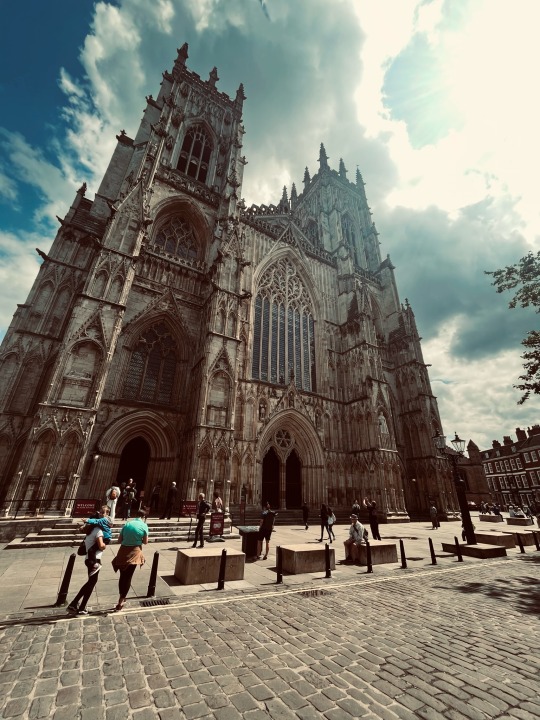

This was one of the most beautiful cathedrals I have visited in the UK. My second favourite would be St David’s Cathedral in Wales.
#gothic#dark acadamia aesthetic#dark academia#naturecore#cottagecore#york#yorkshire dales#cathedral#york minster
14 notes
·
View notes
Text
Walls, Ruins, Minster, & Market - York, England

Today was absolutely amazing - we walked the entire route of the old City Walls of York. We started at the Mickelgate, shown above, where we climbed the stairs and reached the wall, we chose to walk in a clockwise direction around the city. The views from up on the wall were fantastic:
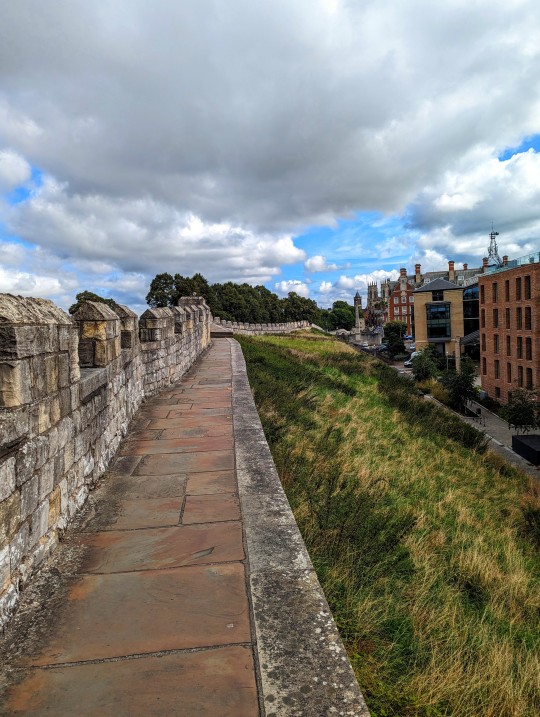
Walking along the portion of the wall that runs parallel to Station Road.
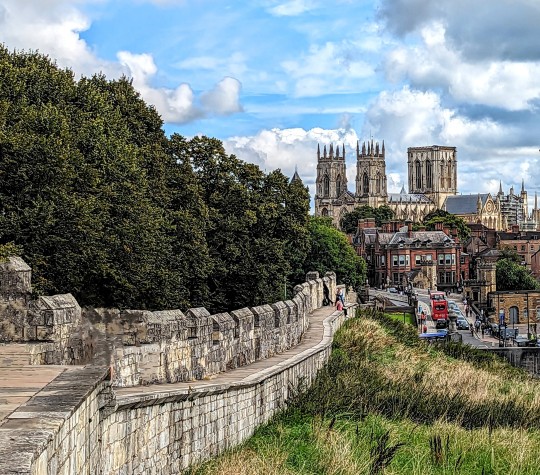
York Minster, in the distance, what an impressive sight!
At the end of the Station Road section, we dropped down off the wall and crossed the River Ouse and entered the Museum Gardens. There are multiple ruins within the gardens, as well as a museum (which we did not visit). The ruins are stunning:

St. Leonard's Hospital entryway.
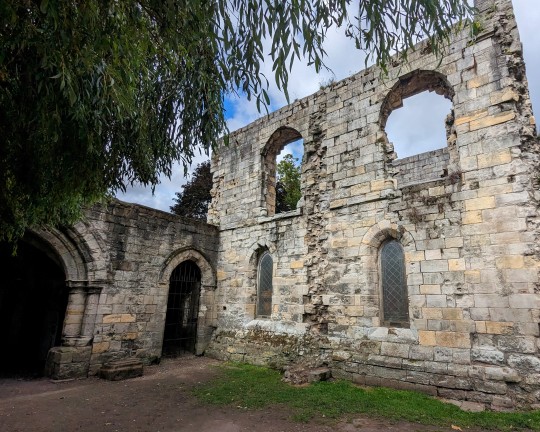
Walls of St. Leonard's Hospital (above) and cloisters (below).
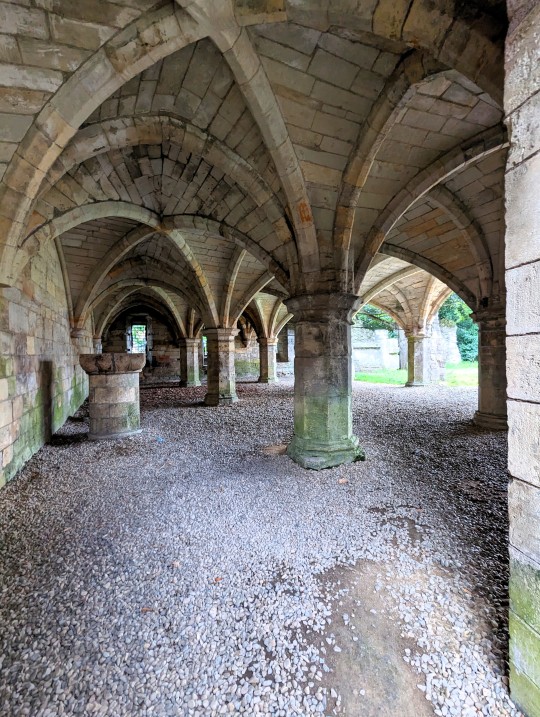
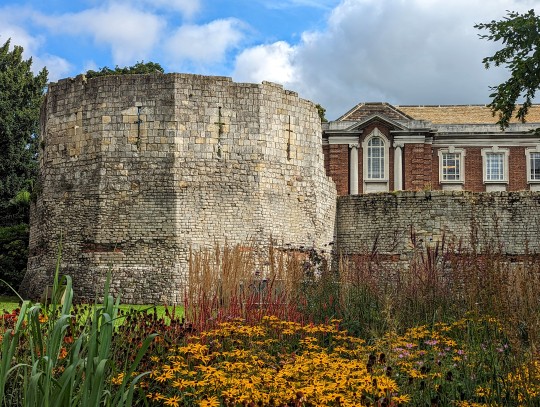
Multi-angular tower, built by the Romans in 107 AD.

The ruins of St. Mary's Abbey, built in 1089 AD, pictured above and below.


St. Mary's Lodge and some of the beautiful blooms in the gardens.
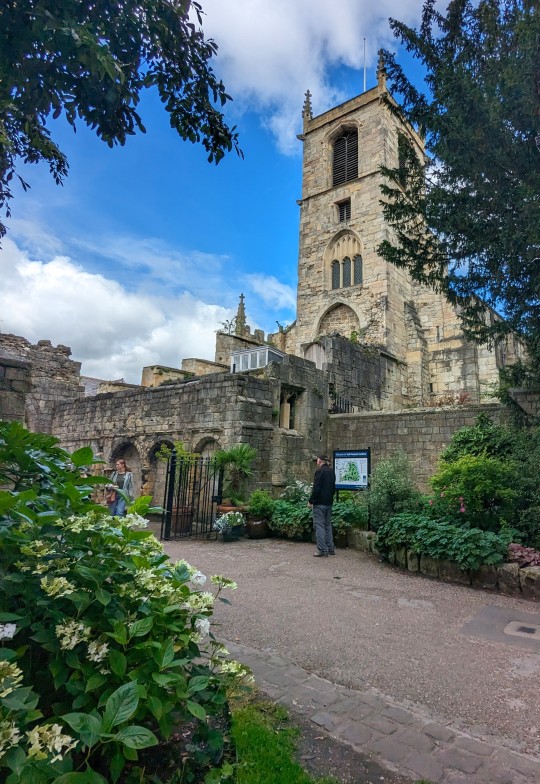
St. Olave's Church.
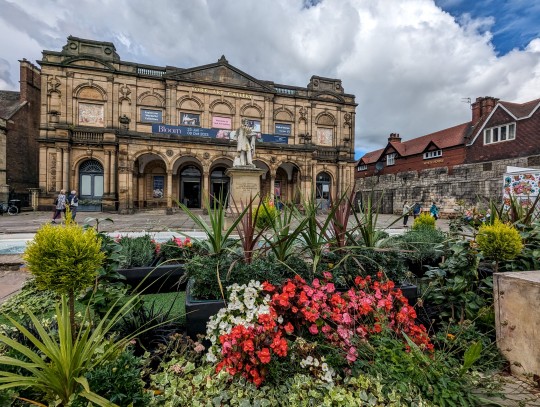
The York Art Gallery.
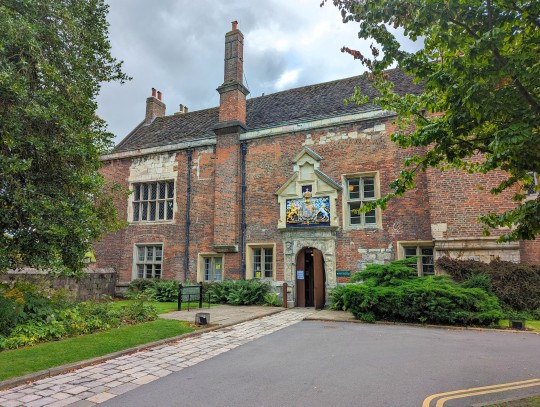
The King's Manor - a house was originally built on this site in 1270 AD, it housed the Abbot of St. Mary's Abbey. It was substantially rebuilt in the late 15th century. It housed the President's Council and several kings stayed here over the years. It is now part of the University of York.
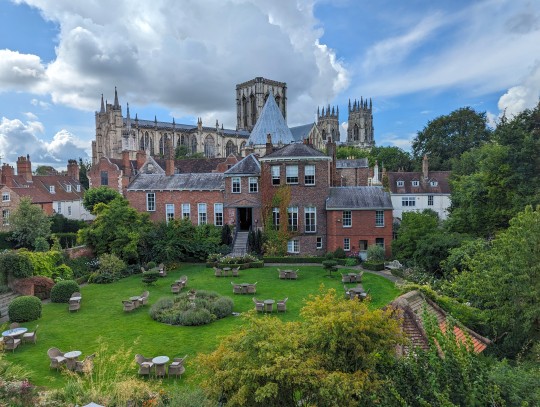
We climbed back up onto the walls and continued our walk - this was the garden of a gorgeous hotel and, of course, York Minster in the background.
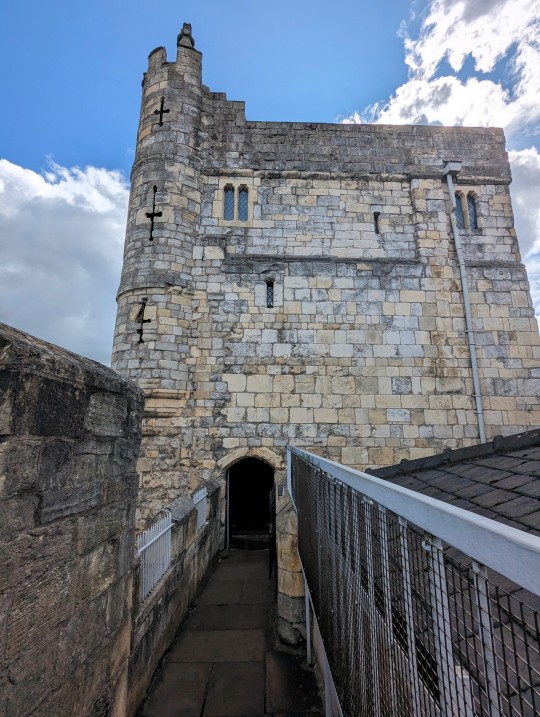
Approaching one of the towers, which housed a small gift shop.
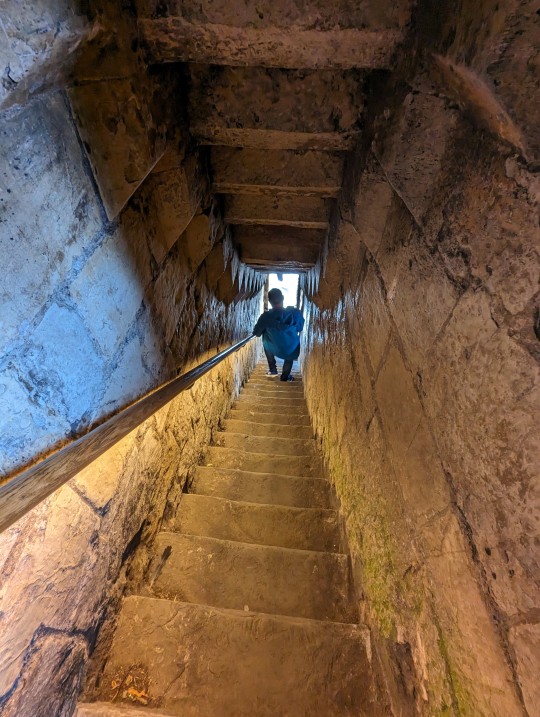
One of the multiple staircases we encountered as we made our way around the walls.

The walls were so cool and look at the amazing weather we had today!
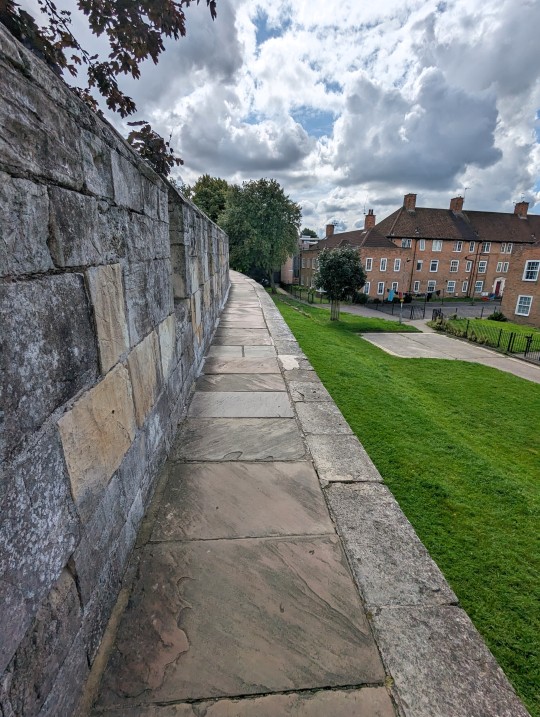
We made our way back to where we started our walk - a total of 3.4 kilometers, all of which was spectacular.
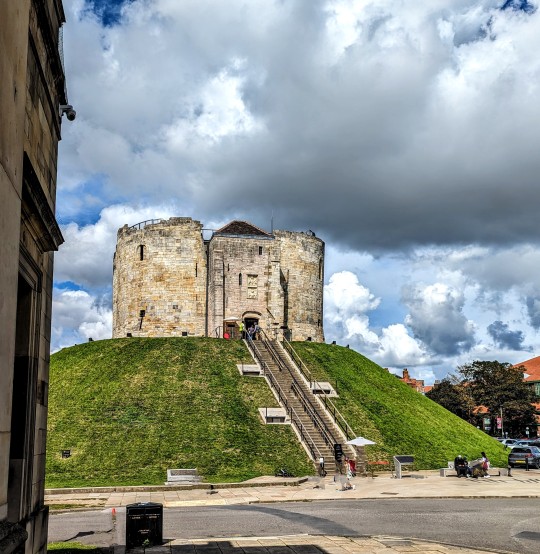
Clifford's Tower - originally an 11th century timber tower, it was burned down in 1190 (after York's Jewish community, some 150 strong, was besieged here by a mob and committed mass suicide). It was rebuilt in the 13th century and probably used as a treasury and prison in later years.
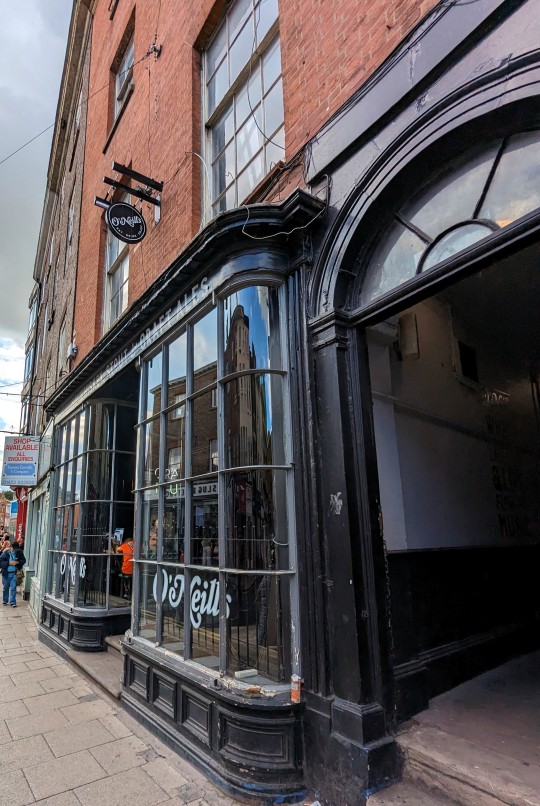
A quick stop at O'Neill's for an adult beverage. This was after we had met a gentleman and his daughter while crossing the street - we proceeded to have a 20-minute conversation with him about our trip and American politics - people here are not afraid to talk about politics. Everyone we meet wants to discuss it - they are fascinated by us, I guess.
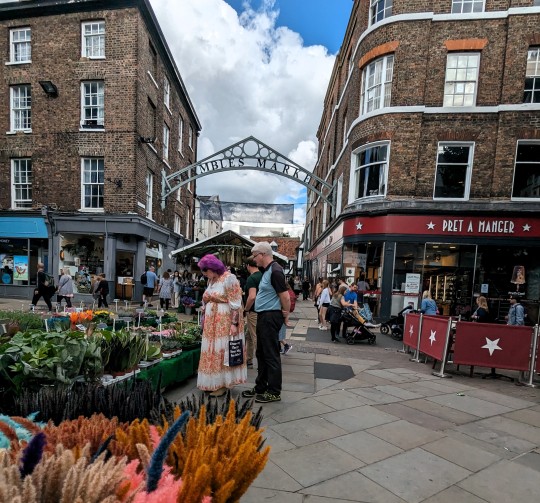
We did a quick walk through the Shambles Market, but it was a bit of a zoo and we decided that we would be happier somewhere else and moved on.
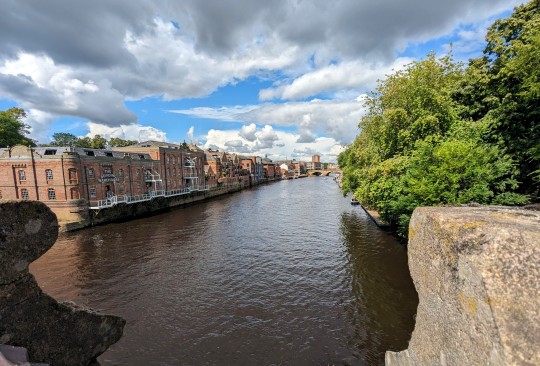
Lovely view of the River Ouse during our walk in York.
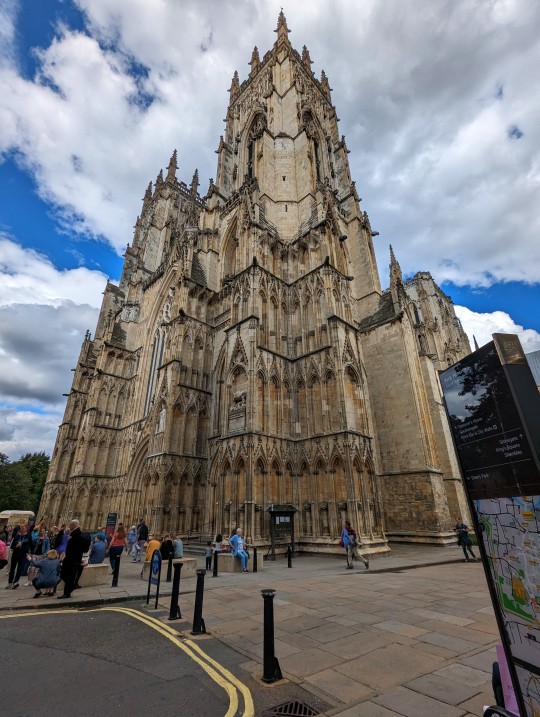
We finally made our way to York Minster - it is massive. It took us a good 20 minutes to walk around the perimeter of it. We chose not to go inside, but we did take a few pictures of the exterior:
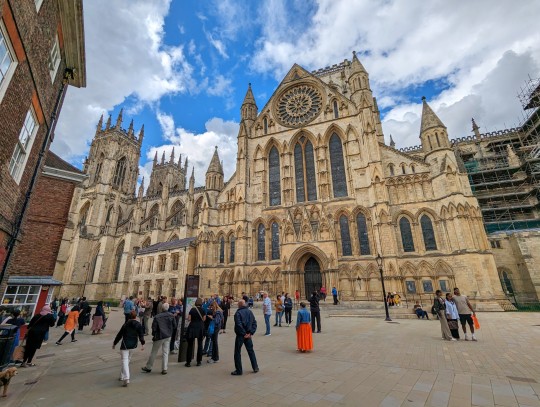
One side of the Minster.
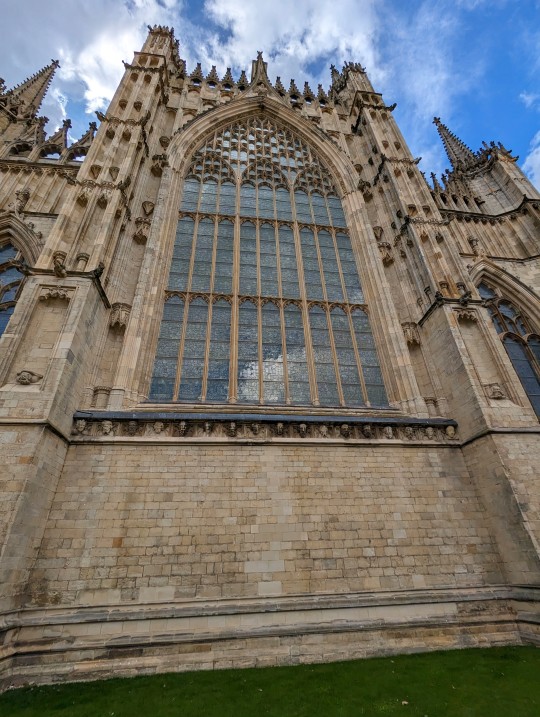
The backside of the Minster.
After walking around the Minster, we headed back towards our Airbnb - passing a couple of other gorgeous old buildings in York.
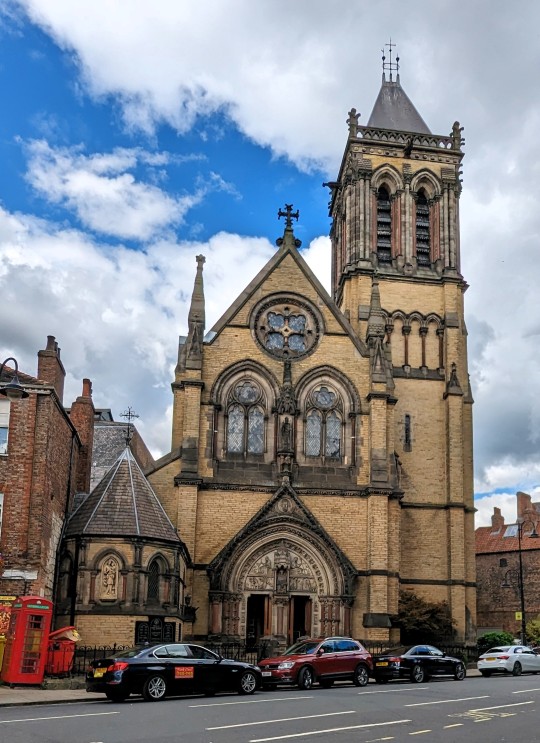
York Oratory.
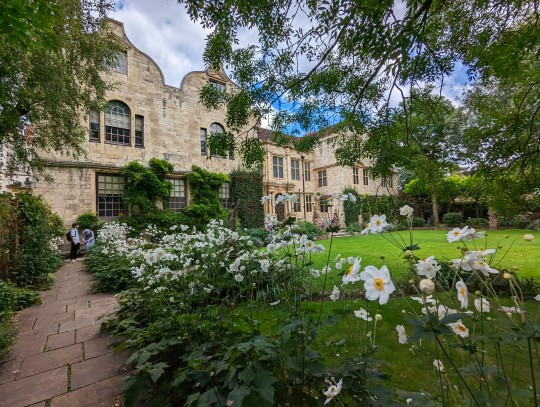
The Treasurer's House.
What a magnificent and full day in York. We decided to eat dinner at one of the pubs near our Airbnb, a little ways away from the city center - which was extremely busy due to the horse racing event. We had a lovely meal and even enjoyed a sticky toffee pudding afterwards.
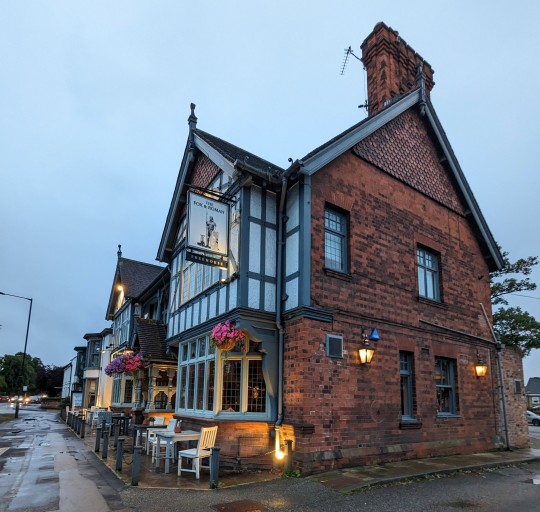
The Fox and Roman - a wonderful neighborhood pub by our Airbnb.
4 notes
·
View notes
Text
Stupid Girl
All the facepalms by all the regulars of all the Star Treks (ALL of them, including all the new shows and the Kelvin timeline) are not enough facepalms for this.
Jane, at the beginning of the story, was a naïve and inexperienced girl. That is no longer so. She bravely escaped the only home she had, with nowhere else to go, fell to an almost literal rock bottom, met people outside of her previous limited experience--not teachers at girls' schools or servants in country mansions--had long talks with a man other than Rochester, lived by herself in a small cottage, therefore running her own household, getting groceries etc, instead of having staff to rely on with domestic tasks. She inherited a fucking fortune, making the commendable decision to split it with her cousins because she felt they deserved it. Yet she has not learned a thing.
You know why I think Jane chose to divide the twenty thousand four ways? Because she wouldn't know what to do with all that money. She made no use of it. The only activity she found pleasure in was giving Moor House a good scrubbing, top to bottom, to make it ready for Christmas, and buying some new furniture and decorations. She started learning German, because Diana and Mary did so, later Hindi because St John asked her to, and occasionally taught at the Morton school, but that was it. Briefly she considered going to India as a missionary, not because it was something she was passionate about, but on St John's suggestion.
When she first came to Thornfield, before the arrival of Rochester, she found life there dull and it was dull. But here she is, all the opportunities for excitement at her doorstep, and she doesn't take them. She does no travelling. She takes no trips to other cities, or to London, to museums, or theatre or opera, or just sightseeing. We know she sneers at fashion, but surely she likes some type of clothes, at least she can't be wearing the same thing every day. In that interrogation by Rochester at the beginning, she admitted she's not read many books and those she did were not very learned, but there's no sign of her buying any new books. The Marmion she reads was a gift from St John. She likes painting, but seemingly has no interest in visiting galleries. To put it plainly, she has no fucking life.
She doesn't open her own school, but I'm thinking she doesn't actually want one--at the time, in the gypsy fortune teller episode, opening her own school was the best it could get for her. Now that she has money she has more options, obviously, she doesn't have to go on "schoolmarming" for the rest of her life. (I mean, who would want to...) Except she doesn't even consider any other option. She's still never visited a city. Or the seaside. All her life experience is limited to countryside; to villages and country mansions. The only men she's ever got close to are Rochester and St John. No wonder she has such a scarcity mentality. She doesn't believe life can get better for her. She's not yet twenty, her whole life ahead of her, healthy and of sound mind and rich to boot. Yet she does an absolute fuck all, apart from listening to St John's long monologues. She thinks she will not marry, not because she doesn't need to depend on a man anymore, or out societal pressure, but because she doesn't believe anyone would ever love her, she doesn't believe there is any man for her, despite talking to all of TWO men in her life.
She likes to paint, yet seeks no new landscapes to capture with her brush. Explore the world, or England at least, Jane! Visit York, see the Minster, the Shambles. Go to the Lake District. Go to the coast. (Anne Bronte loved Scarborough, she died there too, poor soul...)
Yeah, so that double fare didn't cause any dent in her finances. I know that. She was still stupid to pay it, though. Whether she got there on the same day, or on the morning of the next would have made zero difference.
Jane continually looks down on other women for being shallow but it's not that she's that deep herself. Honestly, all she cares about is Rochester. Nothing and nobody else exists for her. During the month of their engagement, she worried she was making him her whole world. She knew being that obsessed with him was not a good thing, but she did nothing to change it. Even after she put a physical distance between herself and him. She was in the prefect position to get over an ex. New life, new friends, and even a new fortune. But no. She passes judgements on everyone that crosses her path, yet brags about not getting over a married man.
There is being in love with someone. And there is being stupid.

The next day, Jane gives an account of what she went through after her escape from Thornfield. Rochester starts asking about St John, as he features so heavily in her narrative (what can I say, I wish he didn't). You know what Jane does now?
She teases Rochester with St John. Because St John was good looking and young and of good character (in Jane's eyes; she likes him, she just isn't in love with him), she is able to make Rochester jealous. Which... girl.
Too little too late. It's like sending a health and safety inspector to Thornfield the day after it burned down. What's the use of it now? She's just travelled all this way to see Rochester, clearly she has no intention to be with another man. She is sitting in his lap, for heaven's sake.
She should have done this when she was still his governess. When the merry company was there and Rochester was pulling that stunt with Blanche. True, there was no suitable guy for that around, but that wouldn't matter, she could have made one up. Say, for example, she comes back from her day or afternoon off and Rochester asks her what she's been doing and she says "oh nothing much, met an old friend from Lowood today for a cup of tea in the village, he used to give us music lessons, he's on his way to Manchester for a new job but stopped by here so that he could see me, we were such good friends back in the day, you know." Even better, ask for an extra time off when the said friend is passing by, so that she can meet him. It doesn't matter if she'd spend the time sitting alone in a village pub.
Another one to file under "what could have been".
And it's not that her teasing goes on for long. Pretty soon she spills out the truth, that St John doesn't mean anything to her and neither does she mean anything to him, that he only wanted to marry her because she would make a good missionary wife.
"But if you wish me to love you, could you but see how much I do love you, you would be proud and content. All my heart is yours, sir: it belongs to you; and with you it would remain, were fate to exile the rest of me from your presence for ever.”
Sir. And she used "my master" sixth time (to the reader, not to him).
He tries to protest, pointing out his disabilities. He compares himself to that chestnut tree under which he proposed to her, the tree that was struck by lightning. (The tree deserved better. Rochester didn't.) Jane responds by continuing with that metaphor and he thinks she means they would be friends (she just declared her love for him (again) but okay).
“Ah! Jane. But I want a wife.”
Of course you do, Edward. Who else will look after you? Mary does all the housekeeping tasks, but it's only a job to her and she has her own husband.
Marriage is beneficial to men. Married men live longer than single men. Don't believe all the lame "ball and chain" jokes.
So he asks her to marry him and she says yes. He emphasises that she will have to wait on him, but she's happy with that.
Of course she is happy with that. She literally walked back into his life carrying him a tray. She'd give her life to serve him. She's always done what he asked her to do, things that were outside her job as a governess. She sat in the drawing room with the guests at Thornfield, she stayed up at night when he needed her to, she kept running to his bedroom the night Richard got stabbed to fetch things, which included a highly suspicious substance (that everyone seems to ignore), she complied with his demand not to talk to Richard, she didn't advertise for a new job when she believed her stint at Thornfield was coming to a close because he told her not to advertise, she keeps calling him "sir" and "master" long after she is not his employee and has her own money. My master, my master, my master, waah-waah-waah. The good, obedient girl, who will help him bury the body. That's Jane Eyre.
And yes, Jane was in no position to refuse her master's orders, especially not as a live-in staff. But she doesn't even wonder why he gives these orders. So much time she spends in her head, talking to the reader, observing Blanche's behaviour, suspecting Grace of arson, pondering Richard Mason's existence, but she doesn't stop once to think about Rochester's motives. Not "why does he make me sit in the drawing room, what's his game?" Not "why should Mr Mason not to talk to me?" Not "how come he has a vial full of liquid from an Italian charlatan? What does he use it for?" The only time she doesn't comply is when she runs away.
At the beginning, when she arrived at Thornfield, she thought it strange that Mrs Fairfax was so friendly to her, when she believed her to be the mistress of the house. But she showed no such surprise when the real master started behaving like a friend.
I think it's real shitty of her to not even acknowledge that Grace Poole wasn't the bad guy after all. But if she did, if she, only in her head, said to herself, "I've been a real fool suspecting Grace of criminal activity", she'd have to also acknowledge that her beloved master was a piece of shit.
And it wouldn't kill her if she allowed at least one semi-friendly thought towards Richard Mason. She didn't have to like him, or talk to him if she didn't want to (not because Rochester demanded it), but again, she could have at minimum acknowledged that it was nice of him to care about Bertha, despite everything she was. And if she really cherished the hope of meeting her newly found uncle one day, why didn't she ask Richard about him?
After they agree they'll marry, Rochester goes on to say that he was wrong in what he did but--let me copy it here:
“Jane! you think me, I daresay, an irreligious dog: but my heart swells with gratitude to the beneficent God of this earth just now. He sees not as man sees, but far clearer: judges not as man judges, but far more wisely. I did wrong: I would have sullied my innocent flower—breathed guilt on its purity: the Omnipotent snatched it from me. I, in my stiff-necked rebellion, almost cursed the dispensation: instead of bending to the decree, I defied it. Divine justice pursued its course; disasters came thick on me: I was forced to pass through the valley of the shadow of death. His chastisements are mighty; and one smote me which has humbled me for ever. You know I was proud of my strength: but what is it now, when I must give it over to foreign guidance, as a child does its weakness? Of late, Jane—only—only of late—I began to see and acknowledge the hand of God in my doom. I began to experience remorse, repentance; the wish for reconcilement to my Maker. I began sometimes to pray: very brief prayers they were, but very sincere."
I don't know. It's at best a half-assed apology. He found Jesus. And it only refers to his demanding her to become his professional mistress. Nothing about all the other stuff, or how awfully he treated the women he had relationships with.
He called her name--loudly--that time she heard him in Morton. But she doesn't tell him she heard him, so as not to frighten him. I can buy it. It's a gothic novel. Still more believable than her collapsing on the doorstep of the people who turned out to be her cousins.
I would have liked it better had he added "waah-waah-waah".
He swears he will live a clean life from now on.
Not like he has any choice. He can't be running off to London or Europe and chase after women anymore. He can't host parties because: 1. nobody wants to attend 2. Ferndean Manor is a hole and a dump 3. he can't see. Sneak in a 4. what is his financial situation now?
Lovers reunited or not, the real winner of this chapter is the driver who got the double fare. I hope he spent it wisely.
2 notes
·
View notes